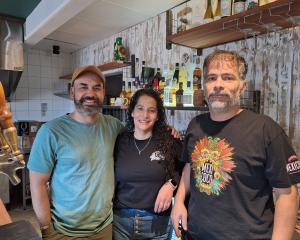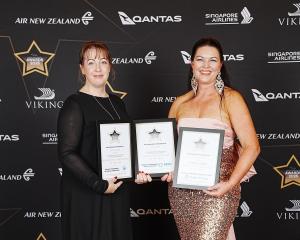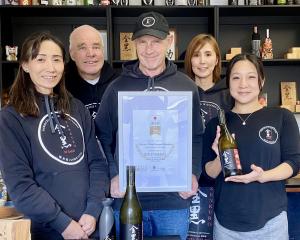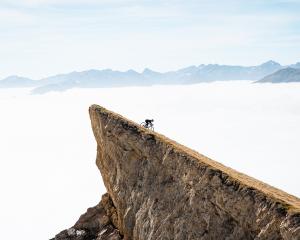The number of injuries on Southern Lakes skifields spiked this month. Reporters Henrietta Kjaer and Matthew Haggart look at why emergency services have been so busy tending to injured skiers and snowboarders this year, and talk to some of those affected.
Skifield accident figures have surged to new heights this winter, mirroring a rise to near-record numbers of visitors at Queenstown and Wanaka skifields.
St John in Wanaka and Queenstown had more ambulance callouts to the local skifields in the first 20 days of this month than for all of July 2009.
Wanaka St John paramedic Don McMillan said the ambulance service had been busier this year.
Since the beginning of July, ambulance paramedics have taken 62 patients from skifields to "various destinations", compared with 56 patients for the whole of July 2009.
In Queenstown, St John has transported 123 patients from the skifields so far this July, against 83 last July. St John Queenstown operations team manager Alana Reid believed the increase was due to higher visitor numbers, rather than increased risk.
"The skifields are safer than they have ever been. This is a numbers game - a reflection of the growing number of people going to the skifields. With incredibly high visitor numbers in Queenstown over the winter festival and the school holidays, we can also expect more people to get injured," Ms Reid said.
All the skifields in the region have reported high visitor numbers over the past three weeks. Coronet Peak mountain manager Hamish McCrostie agreed with Ms Reid.
"Our visitor numbers have been very high over the past three weeks. Seen as an average, our accident rate is largely unchanged from last year."
NZSki, which operates Coronet Peak and the Remarkables, measures accidents in relation to visitor numbers. The accident rate at Coronet Peak is this year 2.5 injuries per 1000 visitors. This figure shows all accidents, not just those requiring a trip to hospital.
A closer look shows the accident rate is 1.8 per 1000 skiers and 4 per 1000 boarders.
At the Remarkables skifield the injury rate is higher, with about 5 per 1000 skiers or boarders.
"The higher figure here is partly because we have a higher concentration of snowboarders, and partly because many come here to enjoy our three terrain parks, where the accident rate undeniably is higher than on regular slopes," Remarkables ski area manager Ross Lawrence said.
Nationwide figures for accidents on the commercial skifield are registered by the Mountain Safety Council. Its report for 2009 shows a national average accident rate of almost four injuries per 1000 skiers or boarders.
Low natural snowfall levels - only one significant snowfall since June 23 - meant snow was packed harder on slopes which could have contributed to more injuries from falls, Cardrona ski patrol chief Geoff Wayatt said.
The Otago Rescue Helicopter service has been called to skifields 11 times since June 22, six of those to Cardrona Alpine Resort.
At Cardrona, Mr Wayatt said skifield medical staff always took a conservative approach to treatment. Although a high number of patients had been transferred from Cardrona, by helicopter and ambulance, "on a number of occasions" the injuries sustained had not been serious.
Skifield medical centres were not set up to treat serious complaints and specialist care was needed for patients suspected of having head, neck, or internal injuries, he said.
NZSki has a contract with the Queenstown Medical Centre, which has a doctor and nurse team stationed at both Coronet Peak and the Remarkables throughout the season. In a case of injury on the slopes, the initial assessment is done by the ski patrol, who are trained in first aid. If medical treatment is needed on the mountain, it will be done by the doctor or nurse.
Dr Sonja Sparrow, of the Queenstown Medical Centre, said four doctors and four nurses were employed to cover the roster.
On the busy days of the school holidays they attended 15-20 people at each skifield, but only a small proportion required hospital treatment.
In the case of serious injury, an emergency call would be made and it would be established whether an ambulance or helicopter was needed to transport the injured person to hospital.
"Helicopter transfers are rare, and we have only had a couple so far this year at Coronet Peak. So far, we have had fewer very serious accidents this year," Mr McCrostie saidMs Reid confirmed St John was also seeing a level of serious accidents so far this year equal to or less than last year.
St John was prepared to handle the increased workload with extra staff in the winter and new ambulances available.
The skifields all stated they tried to minimise injuries by encouraging visitors to take safety precautions.
"We offer free wristguards with rental snowboards, and encourage all skiers and boarders to use helmets, which more and more people do. On the slopes we monitor speed and slow zones closely. Most of all we urge everyone to follow the snow responsibility code," Mr McCrostie said.
SOUTHERN LAKES SKIFIELD INJURIES
An accident report from the Mountain Safety Council showed 5455 skifield accidents were reported in 2009:
• 44% on hard, dry snow.
• 38% on soft, unconsolidated snow
• 11% on spring snow
• 6% on icy conditions
• 1% no snow condition registered
THE COST
• In 2009 there were nearly 25,000 outstanding claims from ski or snowboard accidents, including around 15,400 new claims. The total cost of these ACC claims was $18.8 million.
• This year the number of claims has been counted up until July 5, which only accounts for a few weeks of the ski season, but there have already been 912 new snow sports-related claims.
• The approximately 5000 active snow-sports claims as of July 5 are costing ACC about $5.5 million.
• Snow-sports claims from people who live in the Queenstown and Wanaka area cost ACC just over $4 million in 2009.
• Figures from ACC for 2009 show the main part of the body injured was the knees, which led to 5578 active claims - including 3100 new claims, worth more than $5.2 million.
SNOW RESPONSIBILITY CODE
• Give way to others.
• Stay in control at all times. Know your ability, be able to stop and avoid other people.
• People below you have the right of way.
• Always use a spotter when jumping. Do not jump on to trails and always ensure the area is clear of others first.
• Stop where you can be seen, move to the outside of a trail.
• Brakes or leashes must be used to help prevent runaway equipment.
• If you are involved in, or witness an accident, remain at the scene and identify yourself to ski patrol.
• Obey all ski-area signage. Keep off closed trails and out of closed areas.
• Respect the safety and enjoyment of others.
Source: Mountain Safety Council
Advertisement













